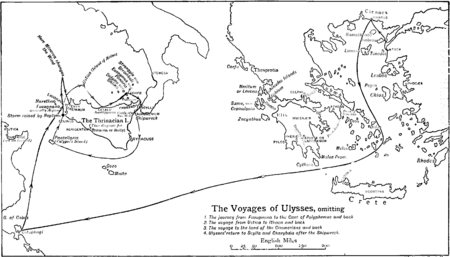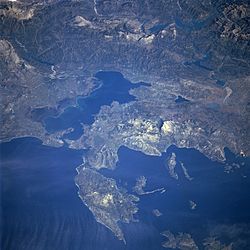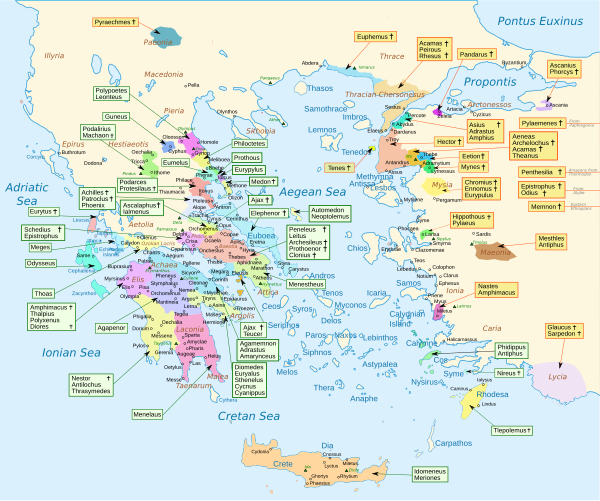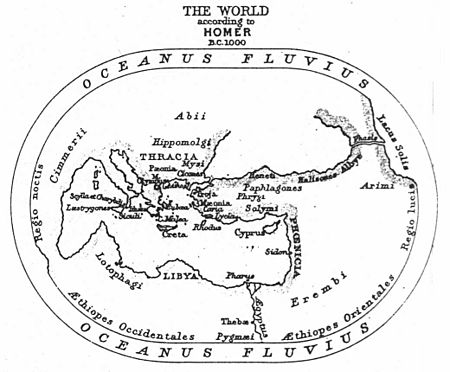Geography of the Odyssey facts for kids
The Odyssey is an ancient Greek epic poem written by Homer. It tells the amazing story of the hero Odysseus and his long journey home after the Trojan War. Odysseus faces many dangers and visits strange lands. For a long time, people have wondered if the places he visited were real.
The story begins in the Peloponnese and the Ionian Islands in Greece. These islands include Ithaca, Odysseus's home. The poem also mentions places like Troy, Phoenicia, Egypt, and Crete. These places were real and known in ancient times.
But what about the other places Odysseus visits? Scholars have tried to find them on maps of Greece, Italy, Africa, and even the Maltese archipelago. However, many experts, both old and new, believe that most of the places Odysseus sees on his journey are not real. As the ancient geographer Eratosthenes once said, "You will find the scene of Odysseus' wanderings when you find the cobbler who sewed up the bag of winds." This means they are probably imaginary.
Contents
Telemachus's Journey: Finding Real Places
Odysseus's son, Telemachus, also goes on a journey in the Odyssey. He travels to Pylos and Sparta in Greece. Finding these places on a map is much easier.
In ancient times, people argued about where Nestor's Pylos was. There were towns named Pylos in different parts of Greece. Today, most scholars agree that Nestor's Pylos was in Messenia. This is because of the Mycenaean ruins found at Ano Englianos. This site is also called the Palace of Nestor. Scientists found ancient clay tablets there called Linear B tablets. They show that the people who lived there called their city Pu-ro, which means Pylos.
Finding Odysseus's Home: The Island of Ithaca
Odysseus's home island of Ithaca is a bit confusing to find. The descriptions in the Odyssey are not always clear.
- Most people think Odysseus's Ithaca is the island we call Thiaki today. Its official name is Ithake.
- However, some scholars believe it might be Leucas.
- Others suggest it could be all or part of Cephalonia.
- Recently, a scholar named Robert Bittlestone suggested that the Paliki peninsula on Cephalonia is the real Homeric Ithaca.
Odysseus's Amazing Adventures: Imaginary Lands?
Odysseus tells his most incredible stories to the Phaeacians. These tales make up a big part of the Odyssey. The places he visits in these stories are very different from real-world locations.
- The names of these places and people are not found in any other ancient records.
- What happens to Odysseus in these places is often magical or fantastic. It's not like the rest of the Odyssey, which feels more real.
- It's possible that even within the story, Odysseus's tales are not meant to be taken as completely true.
- We don't know if Homer, the poet, imagined these places as real.
- Even if they were real, the world has changed a lot over thousands of years. Coastlines and landscapes look different now.
Because of these reasons, experts have very different ideas about where Odysseus traveled. Some believe every stop on his journey was real and can be mapped. Others are sure that these places are purely imaginary.
Ancient Ideas About Odysseus's Travels
Ancient writers had many ideas about Odysseus's journey.
- Some tried to make the mythical stories seem more like history. This is called a "Euhemerist" approach.
- Others connected Odysseus's travels to the founding of new cities. These are called "foundation myths."
Some common ideas that many ancient writers agreed on include:
- The land of the Cyclopes (giant one-eyed creatures) was Sicily.
- The land of the Laestrygonians (giant cannibals) was also Sicily.
- The island of Aeolus (god of winds) was one of the Aeolian Islands near Sicily.
- Scheria, the island of the Phaeacians, was Corfu (modern Corcyra) off the coast of Greece.
- Ogygia, the island of the nymph Calypso, was Gozo, part of Malta.
Ancient Geographers and Historians
Many ancient geographers and historians wrote about Odysseus's travels.
- Herodotus (5th century BC) thought the land of the lotus-eaters was in Libya.
- Callimachus and Apollonius of Rhodes (Hellenistic period) agreed that Scheria was Corfu and Calypso's island was Gozo.
- Eratosthenes (2nd century BC), a famous geographer, was very doubtful. He thought Homer was an entertainer, not a historian.
- Polybius (2nd century BC) disagreed with Eratosthenes. He thought the travels were real and identified Scylla and Charybdis with the Strait of Messina. He also said the lotus-eaters were on Djerba (ancient Meninx) off Tunisia.
- Strabo (1st century BC/AD) tried to balance entertainment and history. He accepted many of Polybius's ideas. He believed the Cyclops and Laestrygonians were in Sicily. He also thought the Sirens were near the Strait of Messina or Naples. However, he thought Calypso's island and Scheria were "imagined in fantasy" in the Atlantic Ocean.
- Plutarch (1st century AD) also placed Calypso's island, Ogygia, in the Atlantic, west of Britain. He even mentioned a "great continent" (possibly America) from which Ogygia was about 900 kilometers (558 miles) away.
Myths of Founding New Cities
Many places in Italy and northern Greece had stories about cities founded by Odysseus or his son Telegonus. These stories helped connect new settlements to the famous Greek hero. For example, an old poem linked Odysseus and the sorceress Circe to the founding of the Etruscan people in Italy.
Modern Ideas About Odysseus's Geography

Today, scholars still have different ideas about Odysseus's journey.
Imaginary Places
Most classical scholars today believe that Odysseus's adventures take place in imaginary lands.
- Ioannis Kakridis, a Greek expert, said that the Odyssey is a poem, not a travel guide. He argued that it's useless to try to map these places. We shouldn't confuse the story with history, especially since it includes gods, giants, and monsters.
- Other scholars, like Merry and Riddell, also said that in books 9-12 of the Odyssey, "we are in a wonderland, which we shall look in vain for on the map."
- Robin Lane Fox noted that stories about heroes like Odysseus were only later connected to real places in Sicily and Italy. These stories helped new communities feel connected to a famous past.
The Western Mediterranean Theory
Some modern scholars and travelers believe Odysseus's journey took him west from Greece into the western Mediterranean.
- Victor Bérard, a French scholar, made a detailed map of Odysseus's travels.
- He placed the Lotus-Eaters in Djerba, Tunisia.
- The Cyclopes were in Posillipo, Italy.
- Aeolus's island was Stromboli.
- The Laestrygonians were in northern Sardinia.
- Circe's home was Monte Circeo in Italy.
- The entrance to the Underworld was near Cumae, Italy.
- The Sirens were on the coast of Lucania, Italy.
- Scylla and Charybdis were at the Strait of Messina.
- The Island of the Sun was Sicily.
- Calypso's homeland was at the Straits of Gibraltar.
- From there, Odysseus went to Scheria, which Bérard, like many ancient writers, identified with Corfu.
- Other writers, like Ernle Bradford, added their own ideas. He thought the Cyclopes were near Marsala in western Sicily and Calypso was on Malta.
- The Obregons suggested the Cyclops and Aeolus were in the Balearic Isles and Scheria was Cyprus.
- Translator Samuel Butler had a unique idea. He believed a young Sicilian woman wrote the Odyssey. He thought the poem's scenes were based on the coast of Trapani in Sicily and its nearby islands.
Around Greece Theory
A smaller group of scholars believes Odysseus's journey was much shorter. They think it happened along the coast of Greece itself.
- The ancient geographer Pausanias (2nd century AD) suggested that Odysseus's trip to the Underworld happened at the Acheron river in northwest Greece. An ancient site called the Necromanteion was later built there.
- Archaeologist Sotirios Dakaris excavated this site in 1958. He found evidence of sacrifices to the dead that matched Homer's description. This made many people believe this was the place Homer described.

- Tim Severin sailed a replica Greek ship to retrace Odysseus's journey. He followed the sailing directions in the Odyssey. He found locations along the northwest Greek coast that seemed to match the story better than the usual ideas. He placed many of the later adventures near the Acheron river. Severin also noticed that the Odyssey mentions many places to the east and south of Greece, but very few to the west. This made him wonder if the western Mediterranean was even known when the original stories were created.
Atlantic Ocean and Other Theories
Some theories place Odysseus's journey even further away.
- Henriette Mertz (20th century) believed Circe's island was Madeira and Calypso's island was one of the Azores. She even suggested that Odysseus's travels recorded the discovery of North America.
- Enrico Mattievich proposed that Odysseus's journey to the Underworld happened in South America. He thought the Acheron river was the Amazon.
- Other extreme views suggest the entire geography of the Iliad and Odyssey can be mapped on the coasts of the northern Atlantic. This theory places Troy in southern England!
- Finally, one recent idea suggests that Homeric geography is actually found in the sky. It claims the Iliad and Odyssey can be decoded as a star map.
See also



